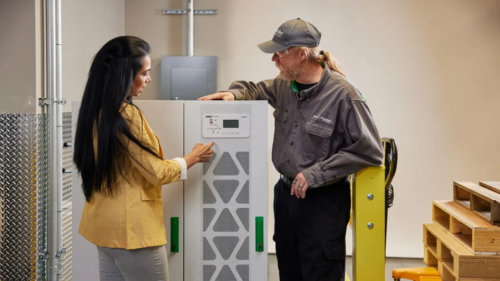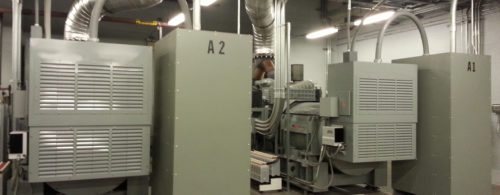Battery Life
Flooded-cell batteries, sealed-cell batteries and flywheels are today's practical choices for reserve power in uninterruptible power supply (UPS) systems. Flywheels are useful for certain space-critical or extreme cycling applications but provide less than one minute reserve, cost more than most batteries and are subject to bearing reliability and seismic issues due to high spin speeds.
Flooded-cell batteries, sealed-cell batteries and flywheels are today’s practical choices for reserve power in uninterruptible power supply (UPS) systems. Flywheels are useful for certain space-critical or extreme cycling applications but provide less than one minute reserve, cost more than most batteries and are subject to bearing reliability and seismic issues due to high spin speeds.
Flooded, or wet-cell, batteries are unquestionably the most reliable choice, exhibiting documented mean time between failure (MTBF) levels many times better than either flywheels or valve regulated lead acid (VRLA) batteries on a string-for-string basis. Additionally, flooded battery jar failures are normally short-circuit in nature, making them transparent to the critical load in the vast majority of cases.
But they are also the most expensive—both on first cost and on installed cost. Consider, for example, the requirements for spill containment, air changeout systems, hydrogen monitoring, eye wash and acid neutralization systems and the large footprint of separate battery rooms.
Currently, more than 90% of installed UPS systems with module power levels ranging up to 500 kVA or more rely on sealed VRLA batteries. In contrast to other types of UPS energy storage, VRLA battery systems avoid most support costs and are sharply lower in initial cost, as well. But the issue has always been maintaining long-term reliability.
A Battery’s Worst Enemy
An often-referenced study by one UPS manufacturer demonstrates that some VRLA batteries can fail en masse in as often as three to five years. Granted, the study encompassed higher-cycling six-pulse rectifier applications and involved older single-phase systems with proven overcharge problems. But the fact remains that these failure rates did occur. So how do we avoid them?
VRLA batteries are one of two types: gel cell or absorbent mat . In the United States, the latter type predominates for UPS batteries, outselling flooded batteries, flywheels and gel cells combined. They are what most people are referring to when they mention VRLA batteries and are more reliable in controlled ambient applications. The focus here will be on the absorbent-mat type. But most of what follows applies to either type of VRLA battery.
A series of factors directly affects VRLA reliability and service life. But heat is perhaps the worst enemy of stationary lead-acid batteries. Depending on manufacturer and product, expected life of all lead-acid batteries will be cut in half for every 10
Next on the list of factors is cycling or battery discharge events. Most UPS systems cycle batteries not just during outages, but also for changes in load levels, as well as large dips in input voltage. In fact, many battery companies now limit warranties based upon the number and duration of these discharge cycles. Charge voltage, current and duration also affect VRLA reliability. Older or defective chargers can overcharge or add ripple current leading to heat buildup and premature failure.
Clearly, it is a good idea to control temperature to 77ected load crashes than actual outages by a surprisingly wide margin.
Continuing Reliability
Today, low-cycle UPS systems are commercially available. Look for systems that avoid slow-response, six or 12 pulse-per-cycle rectifiers in favor of either very fast response IGBT conversion or completely unregulated diode bridge conversion. Finally, check that charger circuits are equipped with temperature compensation and low AC ripple current to avoid thermal runaway and optimize battery life.
But even if all the above factors are carefully addressed, what about continued reliability, say in the fourth or fifth year, with VRLA systems?
Redundancy is not a new concept in mission-critical applications. Yet many would be surprised just how often the essence of this term is missed in designing UPS battery systems. Statistically, one is always best served when investing capital equipment dollars for redundancy in the weakest links in the critical power chain. The most failure-prone link, and the easiest to address, is the DC system. Empirically, the vast majority of UPS DC systems fail far more often than the AC (rectifier-inverter) sections of modern UPS systems.
Most sealed VRLA batteries currently being manufactured and bid for UPS applications in the United States have a five-year design or target life. It could be longer with ambient reduction, cycling and depending on the manufacturer, or it could be shortened by the factors already discussed. Unlike their more expensive flooded counterparts, VRLA cells tend to fail about as often open circuit as short circuit. This is due primarily to dry-out of electrolyte due to venting of generated hydrogen and oxygen from electrolytic charge and discharge through the one-way valves. As suggested earlier, dry-out has an extremely high impact on reliability since a single open circuit cell can make an entire string inoperative.
VRLA batteries are generally supplied one string per cabinet in medium to large systems. There can be as little as one string, or as many as five or six, deployed to provide the required reserve time. Since a great many UPS systems are purchased “low bid,” and many end users do not know the difference, the battery systems provided with such systems could well be the cheapest that meet reserve-time specification. This will invariably mean single string—or even worse, two string designs—for as little as five to 10 mins. of reserve time in UPS systems 150-200 kVA or smaller.
Single string batteries are the most common today. They are cost-effective, and as empirical data confirms, are quite satisfactory for many, if not most, UPS applications, but not for true high-availability (i.e., high 9’s) applications. Two strings can actually be worse than one for some applications with low reserve time, because if either of the two is lost, the entire load is lost—even with a split second outage. This is rather ironic, since VRLA battery strings are relatively inexpensive and easy to parallel (Figure 1).
There’s a Better Way
A better way to design with VRLA for high-availability applications is to understand the costs, as well as the reliability over time, of the various elements of the UPS system and use that in the decision matrix. Looking at the UPS, battery (single-string) and genset components of an overall system, batteries are least expensive, most likely to fail and have the highest impact on critical load crash potential.
For example, let’s assume a UPS design load of 200-300 kVA, a 99.999% availability target and an installed budget of $250,000 for the UPS system and necessary upgrade to the existing diesel genset-backed utility system. Since modern gensets start and accept load in 10 to 30 seconds after power failure, you only need a minimal battery reserve—conventionally, five-minute, but actually only two to three minutes—to effect safe transition. This would likely mean a two-string VRLA battery at this power level. Adding a third string, even with associated and recommended circuit breakers, would typically add perhaps $10,000, or just 4%, to the installed cost. But look at what one gets for the added cost:
-
Fifteen minutes or more reserve time at full load, and over a half-hour at probable initial 50% loading, perhaps enough time to fix a diesel system no-start due to a valve or ATS switch in the wrong position.
-
N+1 redundancy at full rated load, likely N+2 redundancy at initial loading. This improves overall battery system MTBF rating almost one order of magnitude.
-
Elimination of cell reversal , a potentially catastrophic condition stemming from wide disparity in capacities in single-string systems, even if one string is down.
-
Tremendous flexibility in maintaining and changing out battery strings with minimal risk to critical loads.
There are some experts, this author included, who feel that given a choice of either redundant VRLA battery strings and single diesel generator, but with absolutely excellent maintenance and redundant batteries, or redundant gensets and non-redundant VRLA UPS battery, the first choice is always preferred. This is because when most standby duty gensets fail, they do so due to poor maintenance—i.e., bad batteries. Further, they are only required to start in far less than 5% of events that would crash computers or other critical loads.
So, now with an N+1 or even N+2 VRLA UPS battery system, one has access to the final piece of the VRLA reliability puzzle. Today, almost all VRLA battery strings deployed for any single UPS are changed out at once. This is driven in part by cost, but largely by convenience and a pervasive misunderstanding of battery reliability over time. The MTBF rating for any single VRLA battery will not be the same in, say, year five as it will be in year one of service. In fact, the probability of failure will be many times higher. Batteries, unlike other UPS components, are chemical devices, and age plays a key role. The reliability and failure incidence follows a bath tub curve (see Figure 2).
The True Goal
A primary goal of a true high availability UPS maintenance program should be to arrange changeouts so that no more than one string—the “redundant” string—is still in service in the high-risk last year of design life. This is typically year five, but again, will vary with factors above. In a three-string N+1 VRLA design, this would mean changing out the first string prematurely in year 3, the second string at year 4.5, the last string late, perhaps even year 5.5 or later depending upon maintenance test results, operating conditions and budget. Second level changeouts would occur perhaps five years later in each case. The higher the availability requirements, the more string redundancy and/or faster the changeouts.
Good UPS maintenance will include battery voltage, resistance or impedance testing, some of which is built right in to modern UPS charging and monitoring circuits, as well as visual inspection, cleaning and later on, retorquing or infrared scanning connections. This will help determine which jars are more likely to fail in the short term and which are not. With top quality UPS systems and minimal cycling, VRLA cell failures and required VRLA maintenance is almost zero for the first two years. Therefore, UPS facilities and maintenance departments may want to vary preventive maintenance (PM) requirements with the VRLA aging process, particularly if not staggering the changeout schedules. Depending on the battery charging and monitoring system, it may be hard to detect a shorted cell condition in a multiple paralleled string system, which could cause some unequal energy flow and further contribute to fail potential. Rather than the industry-common two PM visits per year, a better designed plan for the same budget dollars might allow one or even zero PM visits the first year, ramping to four PM visits per year by the fourth or fifth year of service.
Overall UPS system reliability is more dependent upon the DC component of the system than any other element. VRLA batteries will remain the DC component of choice for most UPS systems for many years to come. By integrating good system and service design, high levels of VRLA battery reliability can be achieved.
Do you have experience and expertise with the topics mentioned in this content? You should consider contributing to our CFE Media editorial team and getting the recognition you and your company deserve. Click here to start this process.




